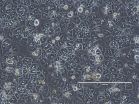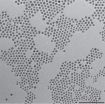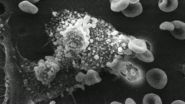(Press-News.org) PITTSBURGH—Electricity and magnetism rule our digital world. Semiconductors process electrical information, while magnetic materials enable long-term data storage. A University of Pittsburgh research team has discovered a way to fuse these two distinct properties in a single material, paving the way for new ultrahigh density storage and computing architectures.
While phones and laptops rely on electricity to process and temporarily store information, long-term data storage is still largely achieved via magnetism. Discs coated with magnetic material are locally oriented (e.g. North or South to represent "1" and "0"), and each independent magnet can be used to store a single bit of information. However, this information is not directly coupled to the semiconductors used to process information. Having a magnetic material that can store and process information would enable new forms of hybrid storage and processing capabilities.
Such a material has been created by the Pitt research team led by Jeremy Levy, a Distinguished Professor of Condensed Matter Physics in Pitt's Kenneth P. Dietrich School of Arts and Sciences and director of the Pittsburgh Quantum Institute.
Levy, other researchers at Pitt, and colleagues at the University of Wisconsin-Madison today published their work in Nature Communications, elucidating their discovery of a form of magnetism that can be stabilized with electric fields rather than magnetic fields. Working with a material formed from a thick layer of one oxide—strontium titanate—and a thin layer of a second material—lanthanum aluminate—these researchers have found that the interface between these materials can exhibit magnetic behavior that is stable at room temperature. The interface is normally conducting, but by "chasing" away the electrons with an applied voltage (equivalent to that of two AA batteries), the material becomes insulating and magnetic. The magnetic properties are detected using "magnetic force microscopy," an imaging technique that scans a tiny magnet over the material to gauge the relative attraction or repulsion from the magnetic layer.
The newly discovered magnetic properties come on the heels of a previous invention by Levy, so-called "Etch-a-Sketch Nanoelectronics" involving the same material. The discovery of magnetic properties can now be combined with ultra-small transistors, terahertz detectors, and single-electron devices previously demonstrated.
"This work is indeed very promising and may lead to a new type of magnetic storage," says Stuart Wolf, head of the nanoSTAR Institute at the University of Virginia. Though not an author on this paper, Wolf is widely regarded as a pioneer in the area of spintronics.
"Magnetic materials tend to respond to magnetic fields and are not so sensitive to electrical influences," Levy says. "What we have discovered is that a new family of oxide-based materials can completely change its behavior based on electrical input."
INFORMATION:
Joe Miksch, University of Pittsburgh News Services
[412-624-4356 (office); 412-997-0314 (cell); jmiksch@pitt.edu]
This discovery was supported by grants from the National Science Foundation, the Air Force Office of Scientific Research, and the Army Research Office.
New discovery could pave the way for spin-based computing
Novel oxide-based magnetism follows electrical commands
2014-09-25
ELSE PRESS RELEASES FROM THIS DATE:
Longstanding bottleneck in crystal structure prediction solved
2014-09-25
Two years after its release, the HIV-1 drug Ritonavir was pulled from the market. Scientists discovered that the drug had crystallized into a slightly different form—called a polymorph—that was less soluble and made it ineffective as a treatment.
The various patterns that atoms of a solid material can adopt, called crystal structures, can have a huge impact on its properties. Being able to accurately predict the most stable crystal structure for a material has been a longstanding challenge for scientists.
"The holy grail of this particular problem is to say, I've written ...
Genetic 'instruction set' for antibodies knocks down hepatitis C in mice
2014-09-25
A triple-punch of antibodies both prevented hepatitis C infection and wiped out the disease after it had established itself in laboratory mice, according to a study led by Princeton University researchers. Instead of delivering the three antibodies directly, the researchers administered a genetic "instruction set" that, once in a cell, developed into antibodies that target the portions of the virus that do not mutate.
Mice treated with the antibody genetic code resisted becoming infected with hepatitis C when they were exposed to the virus, the researchers reported in ...
On the road to artificial photosynthesis
2014-09-25
The excessive atmospheric carbon dioxide that is driving global climate change could be harnessed into a renewable energy technology that would be a win for both the environment and the economy. That is the lure of artificial photosynthesis in which the electrochemical reduction of carbon dioxide is used to produce clean, green and sustainable fuels. However, finding a catalyst for reducing carbon dioxide that is highly selective and efficient has proven to be a huge scientific challenge. Meeting this challenge in the future should be easier thanks to new research results ...
Study: Widespread vitamin D deficiency in thyroidectomy patients
2014-09-25
DETROIT – A new study from researchers at Henry Ford Hospital in Detroit finds widespread vitamin D deficiency among patients who undergo a thyroidectomy, potentially putting them at greater risk for developing dangerously low blood calcium levels after surgery.
Among the patients in the Henry Ford study, 40 percent had low vitamin D levels prior to surgery. Those more likely to be vitamin D deficient are individuals older than age 50, African Americans, Hispanics and patients undergoing surgery for hyperthyroidism.
"The issue of vitamin D deficiency in patients who ...
How to make stronger, 'greener' cement
2014-09-25
CAMBRIDGE, Mass--Concrete is the world's most-used construction material, and a leading contributor to global warming, producing as much as one-tenth of industry-generated greenhouse-gas emissions. Now a new study suggests a way in which those emissions could be reduced by more than half — and the result would be a stronger, more durable material.
The findings come from the most detailed molecular analysis yet of the complex structure of concrete, which is a mixture of sand, gravel, water, and cement. Cement is made by cooking calcium-rich material, usually limestone, ...
BUSM researchers find NAS treatment needs standardization
2014-09-25
(Boston) – When it comes to treating infants with neonatal abstinence syndrome (NAS), researchers from Boston University School of Medicine (BUSM) believe the care for these infants should be consistent and objective, with standardized assessment tools and evidence to back up pharmacologic and nonpharmacologic treatment choices.
The review paper, which is published online in Addiction Science & Clinical Practice, highlights the need for more research in this field to optimize care for both infants and their mothers.
NAS is a collection of signs and symptoms infants ...
Fecal microbiota transplantation recommended for treatment of C. difficile
2014-09-25
(Vienna, October 26, 2014) The transplantation of faecal microbiota from a healthy donor has been shown in recent clinical studies to be a safe and highly effective treatment for recurrent Clostridium difficile (C. difficile) infection and is now recommended in European treatment guidelines.1,2 Faecal microbiota transplantation (FMT) has emerged as a revolutionary, potentially life-saving treatment for this common, difficult-to-treat infection, and is showing promise in the management of other microbiota-related conditions.3,4
Presenting at the 22nd United European Gastroenterology ...
In the face of uncertainty, the brain chooses randomness as the best strategy
2014-09-25
AUDIO:
Editor Karen Carniol interviews Dr. Alla Karpova on her latest Cell paper.
Click here for more information.
Past experience is usually a reliable guide for making decisions, but in unpredictable and challenging situations, it might make more sense to take risks. A study published by Cell Press September 25th in the journal Cell shows that, in competitive situations, rats abandon their normal tactic of using past experience to make decisions and instead make random choices ...
How the brain gains control over Tourette syndrome
2014-09-25
Tourette syndrome is a developmental disorder characterized by involuntary, repetitive, and stereotyped movements or utterances. Now researchers reporting in the Cell Press journal Current Biology on September 25 have new evidence to explain how those with Tourette syndrome in childhood often manage to gain control over those tics. In individuals with the condition, a portion of the brain involved in planning and executing movements shows an unusual increase compared to the average brain in the production of a primary inhibitory neurotransmitter known as GABA.
The paradoxical ...
Modified vitamin D shows promise as treatment for pancreatic cancer
2014-09-25
VIDEO:
Salk scientists find that a vitamin D-derivative makes tumors vulnerable to chemotherapy.
Click here for more information.
LA JOLLA—A synthetic derivative of vitamin D was found by Salk Institute researchers to collapse the barrier of cells shielding pancreatic tumors, making this seemingly impenetrable cancer much more susceptible to therapeutic drugs.
The discovery has led to human trials for pancreatic cancer, even in advance of its publication today in the journal ...
LAST 30 PRESS RELEASES:
Making lighter work of calculating fluid and heat flow
Normalizing blood sugar can halve heart attack risk
Lowering blood sugar cuts heart attack risk in people with prediabetes
Study links genetic variants to risk of blinding eye disease in premature infants
Non-opioid ‘pain sponge’ therapy halts cartilage degeneration and relieves chronic pain
AI can pick up cultural values by mimicking how kids learn
China’s ecological redlines offer fast track to 30 x 30 global conservation goal
Invisible indoor threats: emerging household contaminants and their growing risks to human health
Adding antibody treatment to chemo boosts outcomes for children with rare cancer
Germline pathogenic variants among women without a history of breast cancer
Tanning beds triple melanoma risk, potentially causing broad DNA damage
Unique bond identified as key to viral infection speed
Indoor tanning makes youthful skin much older on a genetic level
Mouse model sheds new light on the causes and potential solutions to human GI problems linked to muscular dystrophy
The Journal of Nuclear Medicine ahead-of-print tip sheet: December 12, 2025
Smarter tools for peering into the microscopic world
Applications open for funding to conduct research in the Kinsey Institute archives
Global measure underestimates the severity of food insecurity
Child survivors of critical illness are missing out on timely follow up care
Risk-based vs annual breast cancer screening / the WISDOM randomized clinical trial
University of Toronto launches Electric Vehicle Innovation Ontario to accelerate advanced EV technologies and build Canada’s innovation advantage
Early relapse predicts poor outcomes in aggressive blood cancer
American College of Lifestyle Medicine applauds two CMS models aligned with lifestyle medicine practice and reimbursement
Clinical trial finds cannabis use not a barrier to quitting nicotine vaping
Supplemental nutrition assistance program policies and food insecurity
Switching immune cells to “night mode” could limit damage after a heart attack, study suggests
URI-based Global RIghts Project report spotlights continued troubling trends in worldwide inhumane treatment
Neutrophils are less aggressive at night, explaining why nighttime heart attacks cause less damage than daytime events
Menopausal hormone therapy may not pose breast cancer risk for women with BRCA mutations
Mobile health tool may improve quality of life for adolescent and young adult breast cancer survivors
[Press-News.org] New discovery could pave the way for spin-based computingNovel oxide-based magnetism follows electrical commands



